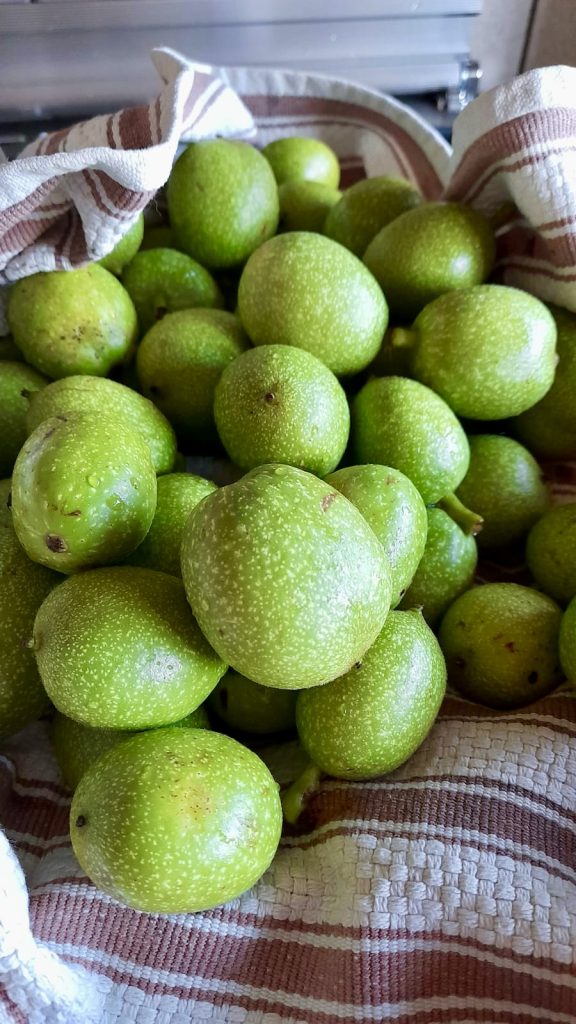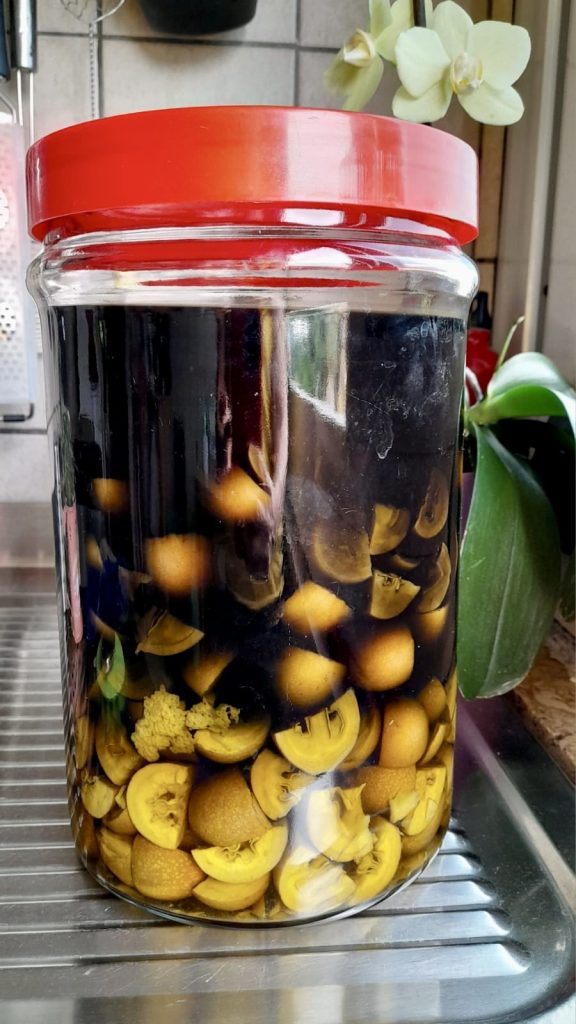Nocino is a liqueur made from walnut husks, through maceration in alcohol. The walnuts are carefully harvested, preferably on St. John’s Day, when they are still young and tender, ready to release their intense aroma and strong flavor. This is where the magic begins: the walnuts are opened, cut into pieces, and left to macerate in alcohol along with spices. After weeks of patient waiting, the nocino reveals its complex and enveloping character. The liqueur takes on a deep hazel color, and each drop offers an explosion of flavors to the palate of those who taste it.
The first sip of nocino awakens the senses with its sweetness and slightly bitter aftertaste. The traditional recipe should be prepared in early summer so the liqueur will be ready for the winter. Just like elderflower syrup, the limited time frame for gathering the raw material makes these preparations even more noble and sought after.
We can use this liqueur as a digestif, and it can be consumed at room temperature or chilled, but never frozen, so there’s no need to store it in the freezer.
Before enjoying a nice digestif, we might have a complete meal like

- Difficulty: Easy
- Cost: Medium
- Rest time: 45 Days
- Preparation time: 35 Minutes
- Portions: 2 bottles of 25.4 oz
- Cooking methods: Stovetop
- Cuisine: Italian
- Seasonality: Summer
- Energy 5,088.70 (Kcal)
- Carbohydrates 239.91 (g) of which sugars 226.24 (g)
- Proteins 52.76 (g)
- Fat 288.85 (g) of which saturated 0.10 (g)of which unsaturated 0.13 (g)
- Fibers 19.52 (g)
- Sodium 38.79 (mg)
Indicative values for a portion of 25 g processed in an automated way starting from the nutritional information available on the CREA* and FoodData Central** databases. It is not food and / or nutritional advice.
* CREATES Food and Nutrition Research Center: https://www.crea.gov.it/alimenti-e-nutrizione https://www.alimentinutrizione.it ** U.S. Department of Agriculture, Agricultural Research Service. FoodData Central, 2019. https://fdc.nal.usda.gov
Ingredients
- 2.2 lbs walnuts (green)
- 4.2 cups pure alcohol (for food use at 95°)
- 6 cloves
- 1/2 cinnamon stick
- 1 lemon zest (small/medium lemon)
- 2.1 cups water
- 14.1 oz sugar
Tools
- 1 Jar
- 1 Strainer
- 1 Pitcher
- 2 Glass bottles
Preparation
After collecting the walnuts, traditionally gathered on the night between June 23rd and 24th, wash them thoroughly and dry them.

Cut the walnuts into four parts and place them in a large, wide-based glass jar. Add the cloves, cinnamon stick, and lemon zest.
Lastly, add the food alcohol.
After adding all the ingredients, close the jar tightly and let it macerate for at least 45 days. It should be left to macerate in a sunny spot, so it gets direct sunlight for a few hours a day. It’s recommended to shake the jar once a day to maximize the extraction from the walnuts.
Day by day, the mixture will start to darken; the photo shows the maceration after a week.
Once the maceration period has passed, prepare the sugar syrup by bringing the water and sugar to a moderate heat. The sugar only needs to completely dissolve, so as soon as it begins to simmer, turn off the heat and stir to help the sugar dissolve and cool.
While the syrup cools, proceed to filter the mixture. To filter it well, cover the strainer with a paper towel to completely separate the liqueur from the walnuts and aromas.
All that’s left is to combine the syrup with the filtered liqueur and, after mixing well to make it homogeneous, you can bottle it.

NOTES
Once bottled, the nocino should be stored in a cool place away from sunlight for about 4 months; it is usually prepared in early summer and consumed around Christmas.
We have already mentioned that nocino is ideal as a digestif, but we can also add it to fruit salads and ice creams.
If you liked the recipe or have any questions, feel free to comment here or on social media Facebook, Pinterest, Instagram, and X.

